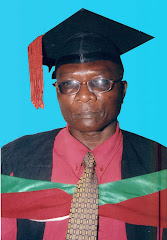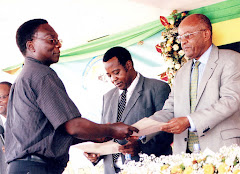I would like to inform readers of this blog that, I have moved temporarily to Iringa town about 502 km away from the city of Dar es Salaam where I am based doing my activities. I am currently in Iringa region in an important mission doing some research works on tourism. I was lucky to have visited the most important attractive historical sites which are found within the region. Just to highlight a bit of m6y research work in this region, let me give you this piece of information as I am preparing other news for you to be posted later. I am stationed in Iringa town which has a long history since pre-colonial time of German rule in 1889 and there is a lot to tell since that time up to the present indeed. Iringa is a developing town located in Southern Highlands region of Tanzania with a population of over 200,000 inhabitants. The name ‘Iringa’is derived from the Hehe word ‘lilinga’, meaning the fort. Hehe, or ‘Wahehe’ in Swahili word is the main ethnic group of Iringa town and its neighboring villages. The tribe is so-called because of their battle cry-he-he-heee. Geographically, the town is situated at a latitude of 7.77°S and longitude of 35.69°E. It’s the administrative capital of Iringa region, one of the four regions of Southern Highland of Tanzania. Other three regions within the zone are Mbeya, Rukwa and Ruvuma regions. Economically the inhabitants of Iringa region are mostly farmers who engage in agricultural production of various types of food, the land is very fertile and receives rains throughout the year. Likewise, the region has many established industries, including manufacturing and food processing. The region is bordered by Singida and Dodoma Regions in the North, Morogoro Region to the East, Ruvuma Region and Lake Nyasa to the South and Mbeya Region to the West. Iringa is a pleasant small town being the third largest town in Southern Highland region of Tanzania after Morogoro and Mbeya and is situated on a plateau that ranges from 1,500metres to 2,500 metres (5.365 feet) above sea level.
 A street in the town centre of Iringa
A street in the town centre of Iringa Its streets are quiet and peaceful, and the market offers a colourful scene of traditional African culture. Iringa overlooks the Little Ruaha River and has become a hub of tourism business for being a popular stopping point for visitors to Ruaha National Park. The town is situated parallel with the Tanzam highway, linked to the main road from the biggest Tanzania’s commercial city, Dar es Salaam and Lusaka the capital city of the Republic of Zambia. The highway distance from Iringa to Dar es Salaam city is 502 kilometers (312 miles). Climatically, Iringa is an interesting and attractive town with a colorful and lively market whereby locally produced baskets and rugs can be purchased. The old Iringa market building is the oldest which was constructed during the German rule in the country. It’s believed to have been the first to be built by the Germans during their time of rule in the then German East Africa colony which later came to be known as Tanganyika (Now Tanzania). The area around Iringa is fertile and is an important agricultural region. The climate is agreeable with a given altitude, in fact it can be quite cool in the evenings, especially in June, July and August. During these seasons of the year, guests are advised to pick up with themselves pullovers, cardigan or sweatshirts as the temperature nears the freezing point.
 Iringa town is coming up with the construction of storey buildings as seen from the background. The trown will be hosting national celebrations on World Tourism Day later in September this year.
Iringa town is coming up with the construction of storey buildings as seen from the background. The trown will be hosting national celebrations on World Tourism Day later in September this year.Iringa region has six districts that includes Iringa Rural, Ludewa, Mufindi, Njombe, Kilolo and Makete. It became a municipal on 1 July 1988. As all other towns wishes aspiring to be municipals, Iringa met various criteria such as a minimum population, capability to fund its services to residents and a communication network to allow movement of goods, people and vehicles. The municipal stretches along a hilltop overlooking the great Ruaha River to the south, and spreads along ridges and valleys to the north. Iringa municipal significant geological features include numerous steep, rocky hills that punctuate the landscape and the little Ruaha River that runs through the municipality which covers an area of 162 square kilometers.
 A portion of the little Ruaha river that forms a boundary between Iringa town and Ipogolo township as seen on the foot of a nearby hill. The scenery provides an attractive outlook.
A portion of the little Ruaha river that forms a boundary between Iringa town and Ipogolo township as seen on the foot of a nearby hill. The scenery provides an attractive outlook.The municipality has one division, 14 wards and 162 mitaas with their sizes that varies significantly. The Ward Development Committees (WDC) administers wards. WDCs comprises the Ward Executive Officer (WEO) and leaders of a particular segmented areas of jurisdiction within the ward popularly known as ‘Ten cell leaders’. The 14 wards are Kihesa, Mkwawa, Mwangata, Kitwiru, Ruaha, Mtwivila, Ilala, Makorongoni, Mivinjeni, Kitanzini, Mshindo, Gangilonga, Kwakilosa and Mlandege. Iringa is a minor transport hub, with regular bus service and trucking to some other important towns and cities in the country such as Dar es Salaam, Dodoma, Mbeya and Songea and most of its electricity power supply comes from the nearby Mtera Dam. Iringa has a long history for being among the few old towns in the country which was built during the 1890s by the Germany Army occupation as a defensive base to be used against marauding Hehe tribal warriors who intended to drive them out of the region. The Hehe uprising which occurred few years later was led by Chief Mkwawa. The fortress and headquarters of Chief Mkwawa was situated in the nearby village of Kalenga 12 km from the town. The Hehe tribe under the strong leadership of Chief Mkwawa put off stiff resistance to the Germans in the late 19th century.
 A huge stone of Gangilonga seen from one of the hills from east direction of Iringa municipal town. A spectacular view of Iringa town can be viewed from its top.
A huge stone of Gangilonga seen from one of the hills from east direction of Iringa municipal town. A spectacular view of Iringa town can be viewed from its top.Gangilonga Rock (The talking stone, a description in Hehe tribe), a site just outside of the town, is a legendary spot where the Hehe Chief at that time, met with senior Hehe tribesmen to mediate on how to fight the Germans. Today, the rock provides an excellent views of the town and the surrounding countryside. Historically, Iringa was also the site of several battles during the first and second world wars, and commonwealth war graves are located just at the town centre. The Germans who were the colonial powers up to the end of the first world war, realized the strategic importance of the town and as a result there are few old colonial buildings they had left. There are some of the original colonial buildings which can be seen in the town strongly built in stone, among them is the Court House and the District Commissioner’s Office. A mix of faded Bavarian and vibrant African architecture distinguish Iringa town from most Tanzanian towns since the place has a rich history in southern region of Tanzania. It was near here that in 1894, The Hehe’s Chief Mkwawa built a 8 km long and 12 meter high stockade in an attempt to fight off the advance of German colonization. The German suffered a humiliating defeat despite of the poorly armed Hehe soldiers who depended on spears and other fiercely traditional weapons and few rifles which they had, but still they ambushed a German battalion.
 Commonwealth graves of the first and second world wars at the centre of Iringa town.
Commonwealth graves of the first and second world wars at the centre of Iringa town.Since the Germans had more sophisticated weapons that spears, bows and arrows the Hehe soldiers had, were no match for the guns the German troops had, they managed to attack the Hehe fortress at Kalenga in October 1894 and Chief Mkwawa successfully managed to escape and engaged in the German forces in guerrilla warfare for a number of years before he committed suicide. In 1898, after nine years of harassing the Germans in a series of guerrilla skirmishes, Mkwawa was cornered by the German troops, and on realizing that he was about to be arrested, he committed suicide rather than being caught red handed by the colonial German troops. As the German troops advanced, they found him dead and cut off his head which was sent to Germany, and repatriated back to the then Tanganyikan territory in 1954 during British colonialism. Mkwawa’s skull now forms one of the main (somewhat grisly) exhibits in the Mkwawa Memorial Museum at nearby Kalenga village.
 Mkwawa’s memorial museum building at Kalenga village.
Mkwawa’s memorial museum building at Kalenga village.Since Iringa town has become a tourist hub for Southern Highlands regions of Tanzania, it has developed to look more like a tourist destination centre with more business incentives ranging from low to high class hotels and restaurants. The recommended hotels and lodgings in Iringa town include the MR Hotel, Hilltop Hotel, Lutheran lodge centre and New Ruaha International guest house to mention a few. These are located within the town. Iringa has a number of historical places to visit such as the Ismila Stone Age site, Kikongoma, Tosamaganga, Kalenga, Mlambalasi, Lungemba and Mbweni and Lugalo monuments. These are mandatory. There are also two monuments located within the town to commemorate soldiers who fought first world war and the Maji maji wars of 1905 to 1909 and 1914 to 1918 respectively. Further a field, one can arrange a day’s visit to the Mufindi tea plantation.
 A monuments carrying the names of soldiers who died during Maji Maji war times of between 1905-1907. This is built in Iringa town near police station.
A monuments carrying the names of soldiers who died during Maji Maji war times of between 1905-1907. This is built in Iringa town near police station.Besides the astonishing free-standing natural rock pillars formed by millions of years of weathering, this is one of Africa’s most important sites for exploring the relics of the Acheulean Age (about 300,000 years ago) and the site is littered with hand axes, hammers, cleavers and stone picks. This is the Isimila Stone Age site which lies about 20 km (12 miles) to the southwest, contains archeological artifacts, particularly stone tools, from human habitation many years ago. The town of Iringa is a fertile area with lots of vegetables, fruits, and tobacco. The famous food factory DABAGA is found there.
Other places worth for visiting is Neema crafts centre for the disabled with an excellent cafe and tours of their workshops available. In Iringa town tourists can get Tour and Safari companies that provide vehicles to hire for the journey to their various national parks like Ruaha, Kitulo, Katavi and Udzungwa mountains National parks.
 These are natural stone pillars formed as a result of soil erosion long time ago, about 300,000 years ago, these natural wonders are features which can be seen at Isimila Stone Age site 20 Km away from Iringa town.
These are natural stone pillars formed as a result of soil erosion long time ago, about 300,000 years ago, these natural wonders are features which can be seen at Isimila Stone Age site 20 Km away from Iringa town.Iringa is a charming and has developed over the years into a pleasant town. During the colonial era, it was the centre for both the German and British settlers who took up land and started farming in the Dagaba. Iringa is at the heart of Tanzania’s tea industry. Sao-Hill and Mufindi areas are well-known places for growing tea, pyrethrum, wheat, maize, vegetables, fruits and tobacco. Most of this so-called alienated land was settled between the two world wars. Educationally, Iringa is more advanced and one can find three institutions for higher education, these are Tumaini University, Mkwawa University College of Education and Ruaha University College and the Regional centre of Open University of Tanzania. Iringa municipality has two FM radio stations and one TV station. The radios are Ebony FM, a youth entertainment and commercial radio, and Country FM. There are other radio stations elsewhere in Iringa region, such as Kitulo community radio in Makete and another FM radio station in Njombe.
PLEASE NOTE THAT A DETAILED REPORT ABOUT ISIMILA STONE AGE SITE WOULD BE POSTED SOON.





























































